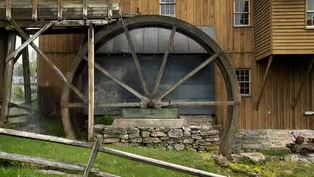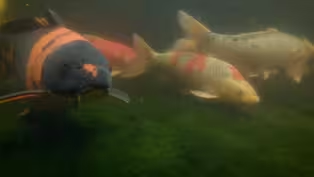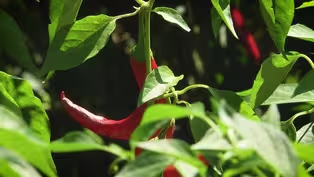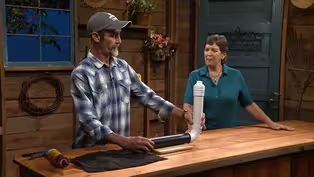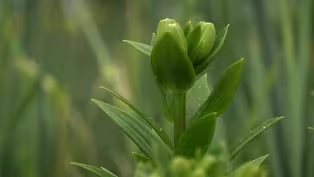Virginia Home Grown
Stone Ground Grains
Clip: Season 23 Episode 3 | 6m 12sVideo has Closed Captions
Learn about the products millers create from corn and wheat
Robyn Puffenbarger shows the various products created by stone grinding corn and wheat, and explains how mixing those items creates products like cornmeal and whole grain wheat. Featured on VHG episode 2303; May 2023.
Problems playing video? | Closed Captioning Feedback
Problems playing video? | Closed Captioning Feedback
Virginia Home Grown is a local public television program presented by VPM
Virginia Home Grown
Stone Ground Grains
Clip: Season 23 Episode 3 | 6m 12sVideo has Closed Captions
Robyn Puffenbarger shows the various products created by stone grinding corn and wheat, and explains how mixing those items creates products like cornmeal and whole grain wheat. Featured on VHG episode 2303; May 2023.
Problems playing video? | Closed Captioning Feedback
How to Watch Virginia Home Grown
Virginia Home Grown is available to stream on pbs.org and the free PBS App, available on iPhone, Apple TV, Android TV, Android smartphones, Amazon Fire TV, Amazon Fire Tablet, Roku, Samsung Smart TV, and Vizio.
Providing Support for PBS.org
Learn Moreabout PBS online sponsorshipRobyn, it's so kind of you to step in and to be able to share what you learned during your visit at the mill.
And I just, you know, these beautiful grains, I just take them for granted that they get ground up.
>>That's right.
So here we have field corn.
This would not be something we would eat, but we do have to dry it and then it can go to Wade's Mill for the stone ground process.
And in any of the grinding processes, you're going to get some chaff, some product that you can't use for human consumption.
>>So what do we do with that?
>>So this could go into an animal feed.
And in the Shenandoah Valley, that would be extremely common.
And as the corn is being ground finer and finer, we would get to something like this, which is actually cornflour.
I didn't even really know this existed.
It feels like silk through your fingers.
>>Oh, I know.
We were playing with this earlier.
It's so soft.
It's so fine.
>>So in order, then, to make product from corn, one of the things we're gonna eat, this is the yellow corn grits, and this is a much coarser meal.
We don't typically use cornflour in our American cooking, but we do use cornmeal, which would be two parts of the flour to one part of the grits.
>>Interesting.
>>And then this feels, you know, just like what you felt when you make cornbread or corn muffins.
>>Kind of a little bit of texture, but not too much.
>>Not too much.
>>I will say that this cornflour is so silky and so soft, I could just touch it all day.
>>Yeah, and, you know, it is gluten free, so I don't know exactly what you could use it for in the kitchen, except that with that gluten free, you might be able to adapt it to some recipes, which would be really amazing.
>>Well, this is a unique ear of corn that I think is just fascinating.
>>So this variety of corn was actually developed and introduced in Virginia in the 1840s and given to settlers by the native people.
It's called Bloody Butcher.
>>Oh, what a name.
>>So it's got a really great name.
(Peggy laughs) And the reason for the name is once you grind it and make this meal, this is maybe what the butcher's apron would've looked like when he was finished, splattered with blood.
>>Yes, splattered.
>>So the Bloody Butcher.
And this makes a beautifully different-looking corn muffin or cornbread because of that cool, cool red color.
>>You know, when we talk about cuisine, we want to have our colors there.
And I was thinking with yellow cornbread and the Bloody Butcher cornbread, it'd just be a very interesting breakfast table.
But, you know, corn is a staple to us and we're so familiar with this, but we also have wheat here, which is another staple that we're familiar with.
And I don't think people realize when they drive by a wheatfield exactly what part is the important part for I'll say food purposes.
>>Right, and this is called a wheat berry.
So this would be the grain that's up at the top.
It's also been dried.
And once they start to do the stone ground process, one of the things that they have to get rid of is the germ.
This is full of oil and it would make the flour go rancid.
So we can't keep that in.
It actually gets sifted out.
>>Interesting.
So if you have a low grade, you know, I'll say milled product, then it still has the oil in it and it won't last as long?
>>Exactly.
You could keep it, but you'd have to keep it in the fridge or the freezer if you have this.
So one of the things that they were doing at the mill was sifting.
This is a whole wheat flour, so it has the flour and that silky feel, but it also has a little bit of the bran left in it.
They're not producing white flour at this time.
The mill used to, that used to be a major commodity, but now they're producing, as far as I know, a whole wheat flour, and that has some of the bran left in it.
>>Well, when we're talking about grinding, you know, we've talked about the importance, I mean, the different stages, these levels of coarse, then medium and fine.
But the operation of the mill itself, I noticed that stone there.
That must get ground down very quickly.
You know, we all think of that one stone rubbing over the other stone to grind this down.
>>Yeah, it was really fun to read about the, you know, we talk about our special thumb measure, and that's from the miller who was actually using his thumb, he was feeling the grain as it's coming out from between the two stones.
So the bottom stone isn't turning.
So that's the sleeper.
And then the runner's on top being turned and then he's feeling for that quality, that coarseness, fineness, as it's coming out.
And that's something that you, like John, would have to learn how to do.
It's a really impressive process.
>>So that's where the phrase rule of thumb came from.
>>Exactly.
>>Oh, that's fun.
>>And don't forget, you have to wait your turn at the mill because the water wheel has to turn and you grind your grain.
>>(laughs) But as that, wow, but the stones and the wheel and everything, I mean, there's so much friction.
I would be so concerned about fire in a mill.
>>Yeah, that was something that John talked about.
You really have to be careful.
There's a lot of dust in the air.
It can be flammable.
And probably a lot of mills that were in Virginia at one time burned because fire was such a major hazard for them.
So now they, you know, just have to be really careful with filtering the air, keeping it open when they're doing their grinding days.
>>But also, I have a millstone in my garden and the grooves there, they actually allowed for I'll say the flour or whatever product to come out, but there was also grooves to allow air in to be able to cool the stone from all the friction.
>>Right.
And in thinking about where those stones came from, there would be local quarries, but they could come from as far away as New York, Pennsylvania.
But the finest stones were from France.
So France goes way back in our history of baking and fine goods.
>>How fun.
>>And so that's, you know, a really high-quality mill would've had French stones.
>>Interesting.
Well, now we know how French cuisine can come to Richmond, actually to Virginia.
So Robyn, I want to thank you so much for sharing this information.
I think everybody learned something today.
>>Thank you so much.
>>Yep.
Video has Closed Captions
Clip: S23 Ep3 | 26m 46s | Discover uses for water in gardening and agriculture beyond sustaining plants! (26m 46s)
Video has Closed Captions
Clip: S23 Ep3 | 8m 39s | Discover how the power of water is used to process grain (8m 39s)
Video has Closed Captions
Clip: S23 Ep3 | 8m 8s | A unique water feature for the front door (8m 8s)
Video has Closed Captions
Clip: S23 Ep3 | 2m 53s | Making chili powder for Korean chili peppers (2m 53s)
Video has Closed Captions
Clip: S23 Ep3 | 4m 54s | How to build a water feature that meets the goals for your landscape (4m 54s)
Video has Closed Captions
Clip: S23 Ep3 | 3m 12s | Learn how to harvest and store rainwater safely (3m 12s)
Providing Support for PBS.org
Learn Moreabout PBS online sponsorship

- Home and How To

Hit the road in a classic car for a tour through Great Britain with two antiques experts.












Support for PBS provided by:
Virginia Home Grown is a local public television program presented by VPM

